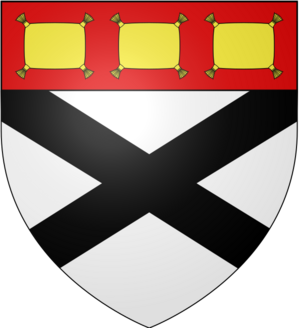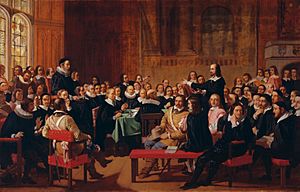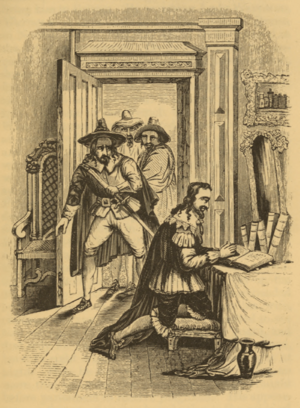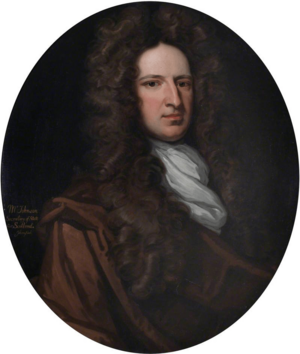Archibald Johnston facts for kids
Quick facts for kids
The Lord Johnston of Wariston
|
|
|---|---|
 |
|
| Personal details | |
| Born |
Archibald Johnston
28 March 1611 (baptised) |
| Died | 22 July 1663 (aged 52) (hanged) |
Archibald Johnston, Lord Wariston (1611 – 1663) was an important Scottish judge and political leader. He lived during a very troubled time in Scotland's history.
He helped write the Scottish National Covenant in 1638. This was an important document for the Scottish church. He also became the main lawyer for the Scottish Church, known as the Procurator of the Kirk. People said he believed the predictions of a woman named Margaret Mitchelson.
Johnston helped make peace agreements like the Pacification of Berwick in 1639 and the Treaty of Ripon in 1640. In 1641, he became a judge, called a Lord of Session, and was known as Lord Warriston. He was a representative for Midlothian in 1643. He did not want Scotland to stay neutral in England's problems.
He played a big part in the Westminster Assembly, a meeting about religion. In 1644, he joined the Committee of Both Kingdoms. This group represented Scotland in London. King Charles I made him Lord Advocate (a top legal officer) in 1646. He was against the "Engagement" of 1648. This was an agreement between some Scots and the King. He might have created the Act of Classes in 1649. This law removed Royalists from public office. He became Lord Clerk Register (a high government official) in 1649. People say he gave bad advice to General Leslie at the Battle of Dunbar in 1650. After this battle, he lost his government jobs.
In 1657, Oliver Cromwell, who ruled England at the time, gave him back his job as Lord Clerk Register. Johnston was a leader of a group called the Remonstrants. He was also a member of Cromwell's House of Lords. He served on the Council of State. When the Rump Parliament returned in 1649, he became the permanent head of the Committee of Safety.
After the king returned to power in Scotland, Johnston had to flee. He was sentenced to death while he was away. He was caught in Rouen, France. With the French king's permission, he was sent back to Britain. After being held in the Tower of London, he was hanged in Edinburgh on July 22, 1663.
Contents
Early Life and Education
Archibald Johnston was the son of James Johnston. His father was a merchant in Edinburgh. Archibald was born around March 28, 1611. He studied at the University of Glasgow. In 1633, he became a lawyer.
Standing Up for the Church
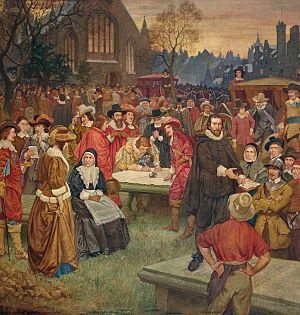
Johnston first became well-known in 1637. This was when King Charles I tried to force a new church style on Scotland. This style was called Episcopalian. It was different from the Scottish Presbyterian church. Johnston was a key advisor to the Scottish leaders. He wrote their protests against the King's changes.
On February 22, 1638, he read a strong protest. He read it to a huge crowd in Edinburgh. This happened at the Mercat Cross. He and Alexander Henderson wrote the National Covenant of 1638. Johnston wrote the second part. It listed all the old laws that were against "popery" (Catholicism). It also supported the freedom of the Scottish church. He was said to believe the predictions of Margaret Mitchelson. She said the National Covenant would succeed.
Johnston became a clerk for the "Tables." This was a group of revolutionary leaders. He also became a lawyer for the General Assembly of the Church. This meeting was held in Glasgow that same year. He found several missing church records there. In June 1639, he helped with peace talks. These talks led to the Pacification of Berwick. This ended the first Bishops' War.
His strong stance upset the King very much. Charles promised a new Assembly and Parliament. Johnston accused the King of just trying to gain time. The King got angry and told him to be quiet.
In August, Johnston read a paper to the Parliament of Scotland. It strongly criticized the Parliament being stopped. The next year, he was asked to work with the army general. On June 23, he wrote to Lord Savile. He asked for support from English leaders. He wanted them to accept the National Covenant.
In October, Johnston helped negotiate the Treaty of Ripon. He went to London for this. After the peace, he pushed for punishment of those who caused trouble. He especially wanted to punish Traquair. He also spoke privately with the King. He was against a law that would forgive everyone. When the King came to Scotland in 1641, Johnston led the opposition. He argued that Parliament should control government jobs. He used old records he had found to support his argument.
Becoming Lord Warriston
In September 1641, the Scottish Parliament thanked Johnston for his work. The King was trying to make peace at this time. So, on November 13, 1641, Johnston became a Lord of Session. He was given the title Lord Warriston. This name came from his estate at Currie. He had bought it in 1636. He was also made a knight and given money each year. That same month, Parliament made him a commissioner. He was to help settle Scottish affairs in Westminster.
Lord Warriston was key in making a treaty with the English Parliament in 1643. He became a member of the Committee of Both Kingdoms in London. This group managed military actions. He went on several trips to meet with army generals. He also helped write the Treaty of Uxbridge in 1644. This treaty was not successful. He joined the Westminster Assembly that same year. He strongly opposed allowing different religious groups to exist freely.
Besides his work in England, Warriston was a member of the Scottish Parliament. He represented Edinburgh county from 1643 to 1647. He served on many committees. After King Charles was defeated, Johnston became Lord Advocate in October 1646. The Scottish government also gave him money for his services. He continued to oppose giving in to Charles. He strongly disagreed with the "Engagement" of 1648. This agreement was made by Duke Hamilton with Charles. It did little for Presbyterianism but made Scots fight the English Parliament.
The Remonstrants and Later Years
Warriston became a leader of the Kirk Party. This group was against the Engagement. When the "Engagers" were in power, he stayed with the Marquess of Argyll. He returned after the "Whiggamore Raid." He met Cromwell in Edinburgh in October. This was after the Engagers were defeated at Preston. He worked with Argyll to create the Act of Classes. This law, passed in January 1649, removed royalists from public jobs.
However, the good relationship with Cromwell soon ended. This was because the King was executed. Warriston was officially present when Charles II was declared King in Edinburgh. This happened on February 5, 1649.
On March 10, 1649, Warriston became Lord Clerk Register. In May, he announced the death sentence for Montrose. He is said to have watched Montrose being taken to his execution. He was at the Battle of Dunbar (September 3, 1650). He was part of the Committee of Estates. After the defeat, he wanted General Leslie removed from command. On September 21, he gave a strong speech. He blamed the Stuarts for all the recent problems. He said they opposed the Reformation.
After Dunbar, the Committee of Estates decided to change the Act of Classes. This was to allow a new army to be formed. This army would include royalists. Warriston and other strict Presbyterians disagreed. They wrote a "Remonstrance" or protest against this. The Act of Classes was removed. But this disagreement caused problems in the Church of Scotland for many years.
In 1656, Warriston went to London. He represented the "Remonstrants." On July 9, 1657, Cromwell gave him back his job as Lord Clerk Register. On November 3, he became a judge in Scotland. He stayed in government until the King returned to power. In January 1658, Cromwell made him a member of his new House of Lords. He also served in Richard Cromwell's parliament. When Richard Cromwell left power, Warriston joined the Council of State. He also became a member of the Committee of Public Safety.
The King Returns
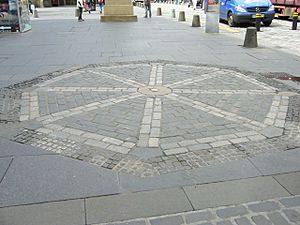
Johnston lived in a large house in Edinburgh. It was at the bottom of Warriston Close. This street was named after him.
When the King returned to power in Scotland, Warriston was not forgiven. On February 1, 1661, he was called to appear before Parliament. He was accused of high treason. But he had already fled to Holland and then to Hamburg, Germany. So, he was sentenced to death while he was away. This happened on May 15, 1661. He also lost all his property and title.
In 1663, he went to France. He was found in Rouen. With the permission of King Louis XIV, he was sent to England. He was put in the Tower of London. In June, he was taken to Edinburgh. He was held in the Tolbooth prison. He was hanged on July 22 at the Mercat Cross in Edinburgh. This was the same place where he had given many important speeches. It was about 100 yards from his own house. His head was cut off and displayed on the Netherbow, a town gate. Later, it was buried with his body in Greyfriars Kirkyard.
His Character and Beliefs
Johnston was a very energetic and smart man. He worked hard to protect the Presbyterian church in Scotland. His friend Robert Baillie called him "one of the most faithful and diligent and able servants." He knew a lot about Scottish law. He was also a good speaker and very religious. His strong belief in the Scottish church was sometimes seen as extreme by others. His nephew, Gilbert Burnet, wrote that Johnston believed the Covenant made Christ the true ruler.
Johnston was not naturally against kings. In fact, he often defended the King's power. But when the King attacked the Presbyterian church, Johnston wanted to limit the King's power. He tried to do this using old laws and traditions.
Johnston's decision to work for Cromwell was not as bad as some people say. He had more in common with Cromwell than with the royalists. He could also do useful work in his government job. Johnston sometimes lacked tact and was not always kind to his opponents. He admitted that his temper could be "hasty and passionate."
King Charles I disliked him. King Charles II hated him. Johnston had criticized Charles II for not being committed enough to the Covenants. But Johnston was good friends with Argyll. They worked together in public life.
His Family
Archibald Johnston had a large family. His most famous son was James Johnston (1643–1737). He was known as Secretary Johnston. After his father was executed, James fled to Holland. He returned to England before the Glorious Revolution of 1688. In 1692, he became one of the secretaries for Scotland. But he lost this job in 1696. Under Queen Anne, he again became involved in public life. He was made Lord Clerk Register. James Johnston spent his later years at his home in Twickenham. He died in Bath in May 1737.


